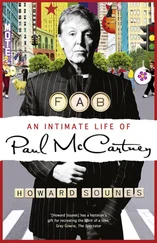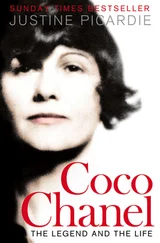Once again, Gabrielle’s presence at an avant-garde event was appropriate: Cocteau’s ballet was at one with her own path. (Their friendship was almost inevitable.) Borrowing from workaday wardrobes and using modest materials, Gabrielle was the designer then showing that a democratization of fashion was possible. And while her daring hints at classlessness were at first taken up only by a wealthy clientele, as time went on, her simple designs and “modest” materials would be transferred from the salons to the streets. All over France, and abroad, women would be able to copy Gabrielle’s styles, allowing more of them than ever before to take part in the game of fashion.
13. Remember That You’re a Woman
A few days after the premiere of Parade , the woman then regarded as France’s finest classical actress, Cécile Sorel, gave a dinner to celebrate the ballet, and to which she invited a novel mix of guests, which included Arthur and Gabrielle. Cécile Sorel understood that while Arthur was one of Paris’s most eligible bachelors, Gabrielle’s presence as an avant-garde designer gave her evening greater cachet.
Sorel’s dinner party would be long forgotten if it hadn’t been recorded by that urbane future novelist the diplomat Paul Morand, who made it his business to attend the numerous Parisian social events during those strange war years. Sorel’s unorthodox guest list included Morand’s boss, Philippe Berthelot, one of the highest-ranking French diplomats; a fashionable artist, the immensely rich and mad Spanish painter José Maria Sert; Sert’s twice-divorced and most unconventional mistress, the Slav patroness and artist’s muse Misia Edwards; the literary gadfly and artist Jean Cocteau; a playboy businessman, Arthur Capel; and his mistress, Gabrielle, a lower-class couturier.
While Morand’s snobberies had him imply he wasn’t at the dinner and refer to Sorel’s unconventional social mix as “preposterous,” he also noted with interest Gabrielle’s presence. Her achievement of a most unusual thing — the advancement of a couturier from “mere” dress-designer status to the drawing rooms of the Parisian elite — fascinated the novelist in Morand. And while he noted that Gabrielle was the least socially significant person at that dinner, he referred to her as “Coco Chanel, who is definitely becoming quite a personage.”
The second matter of note about that evening at Cécile Sorel’s recorded by Morand was that both Cécile and Gabrielle had done an outrageous thing: they had cut off their hair. “In the last few days it has become the fashion for women to wear their hair short. They’re all doing it, Madame Letellier [a mistress to the late Edward VII] and Coco Chanel in the lead, then Madeleine de Foucault, Jeanne de Salverte, etc.” 1
Jean Cocteau told Morand that “this fashion was launched for charitable purposes — that all the cut hair is put together… and sold for the benefit of the wounded.” One can only say that this reveals nothing more than how far removed Cocteau was from what these women were thinking. (This we will come to in a later chapter.)
It has always been said that it was at Sorel’s dinner, in mid-1917, that Gabrielle first met Misia Edwards. 2The two women had actually met a year earlier, in 1916. This meeting would develop into a lifelong friendship, becoming infamously rich in complexity and conflict.
Misia Edwards is traditionally credited as the person who cultivated Gabrielle, the person who expanded her horizons beyond sportsmen and business. This, however, underestimates Gabrielle herself and the position she had already come to inhabit as the mistress of a cultivated man. First, with so little known about Arthur until now, it has been impossible to appreciate the full extent of his influence upon Gabrielle. Second, as Gabrielle would obscure so much detail of this period in her life, a source used repeatedly for information on her meetings with figures of any cultural note is Misia Edwards’s memoir. 3Misia Edwards was an extraordinary woman of remarkable cultural influence, but she was also a breathtakingly self-absorbed one, and her late-life memoir was written as much as anything with a view to signaling her own part in the development and advancement of numerous twentieth-century artists’ careers.
While Misia was completely sincere in her belief that Gabrielle’s role in their times was a highly significant one, she also believed that without her, Misia, the world would not have recognized Gabrielle’s gifts, society would not have welcomed her and she would not have become involved with the artists who were making those feverishly creative times. Misia wrote, “One could say that it is easy to help a beautiful diamond to shine. Still, it was my privilege to help it emerge from its rough state, and — in my heart — to be the first person dazzled by its brilliance.” 4
Although Misia was not the first to introduce Gabrielle to any kind of culture, what she was the first to do was introduce her to the core of the Parisian avant-garde. Having said that, these artists were inverted snobs of a high order, and even an introduction by the famed Misia Edwards — muse and patron to so many of them — would not have been enough to gain Gabrielle admittance to their circles. Her own personality and originality would almost certainly have led her to them anyway. Unlike Misia, who was invaluable as a muse and patron, Gabrielle had the character of an artist. Her acceptance within the spectrum of the avant-garde came about, above all, because she was recognized as a kindred spirit.
Recalling that evening, in 1916, when she first met Gabrielle, Misia would say:
My attention was immediately drawn to a very dark young woman… She radiated a charm I found irresistible… She seemed… gifted with an infinite grace and when, as we were saying goodnight, I admired her ravishing fur-trimmed red velvet coat, she took it off at once and put it on my shoulders, saying with charming spontaneity that she would be only too happy to give it to me… Her gesture had been so pretty that I found it bewitching and thought of nothing but her.
The next day I could hardly wait to see her in the rue Cambon… When I arrived, two women were talking about her, calling her “Coco.” I don’t know… but my heart sank… Why trick out someone so exceptional with so vulgar a name?
Magically the hours sped by… even though… she hardly spoke… That same evening Sert and I went to dine at her apartment… There, amidst countless Coromandel screens we found Boy Capel… Sert was really scandalized by the astonishing infatuation I felt for my new friend… And I myself was rather surprised that a woman I had met the night before could already fill such a place in my thoughts. 5
Misia’s description is borne out in Morand’s novel Lewis et Irène— where Irène bears such a resemblance to Gabrielle — when Morand describes the singular character of his heroine:
Irène proved very popular. Paris had plenty of businesswomen, but they were talented dressmakers, lucky actresses… who were only looking at generating profits, to establish themselves, to be accepted, to deal with famous men, thus showing the limit of their ambitions… Irène was liked because of her grace, her absence of… pretensions, her direct manners, her simple and imperious mind. She was courted. Lewis was not jealous. 6
When Arthur’s political profile was in the ascendant with the men prosecuting the war, his encouragement and financial backing also continued being a source of stimulation to Gabrielle. But they were also often apart. Arthur was unable to remain faithful, and Gabrielle was becoming more self-reliant.
Arthur was, like so many, apprehensive about the conflict causing the disintegration of social cohesion, and at this point he felt driven to begin his second book. One of the central planks of this work was the new position of women, and he heralded women’s changed lives, rejoicing that their inferiority had been only an “illusion of the other sex.” His own mistress was acquiring a name as a working woman, and with her growing “equality,” she was the perfect example of just what Arthur was espousing.
Читать дальше












